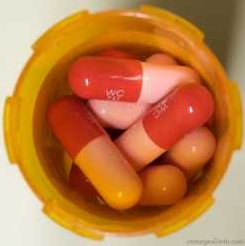
Overview
Microbes: Can't live with them, can't live without them. We focus more on the first of these truths, as shown by the huge sums spent every year on preventing, treating, and researching infectious diseases. But the second is equally valid: Each human body contains at least 10 times as many microbes as human cells. The human gut alone contains about 1 kilogram of bacteria indispensable to digestion.
But sometimes microbes get out of hand, triggering everything from athlete's foot to influenza pandemics that kill tens of millions, and for millennia humans have sought ways to control them. People have tried everything from prayer, to natural biocides (Ötzi, the 5,300-year-old hunter found frozen in an Alpine glacier in 1991, carried fungal oils to treat intestinal parasites), to cautery (scorching wounds with a hot iron).
The results were mixed at best. Then, in 1929, Alexander Fleming noticed a clear zone on an agar plate of staphylococci bacteria "contaminated" with Penicillium mold. Ten years later, Ernst Chain and Howard Florey found a way to isolate the active ingredient. Penicillin was used to treat infections in World War II and was commercialized immediately afterward. From this accidental beginning, the global anti-infective market has grown to nearly US$70 billion a year; antibiotics account for about half.
Production
Producing mass quantities of antibiotics requires a bioindustrial fermentation technique. The source microorganisms, usually genetically modified strains of naturally occurring microbes, are grown in enormous vats of liquid growth mediums under carefully controlled conditions. The antibiotic compounds are actually metabolites of the microbes; these compounds are isolated, often using various organic solvents, then extracted, purified, and refined into one of several drug forms.
Impacts
The chief downstream impacts of antibiotic use involve antibiotic resistance. Resistance is natural; microbes that produce antibiotics do so to stave off competition from other microbes, which in turn evolve to escape harm. This co-evolutionary dance is expanded and accelerated by the immense scale of human antibiotic use - and misuse.
Antibiotic resistance developed almost immediately after commercial production of antibiotics began in 1946. It has since become a major threat to the control of pathogens, nearly all of which are resistant to one or more standard antibiotics. Resistant pathogens have become common in institutional settings such as hospitals and nursing homes; according to the U.S. Centers for Disease Control, about 70 percent of common hospital infections are resistant to at least one antibiotic. One of the most common institutional microbes, methicillin-resistant Staphylococcus aureus, kills more people in the United States each year than AIDS.
Microbes' inherent tendency to develop antibiotic resistance is aggravated by human actions. For example, microbe resistance genes are sometimes used as markers in genetically modified crops and wind up in the products made from them. Antibiotics are often misused in medical settings, as when patients demand antibiotics for viral infections, against which they are useless. Even when the prescribed antibiotics are appropriate, patients often fail to use them properly. Both practices increase antibiotic resistance.
Perhaps most important, nearly 70 percent of U.S.-produced antibiotics and related drugs are fed to livestock to promote growth and prevent sickness. These uses help create resistant pathogens that can reach people directly via the meat and byproducts or indirectly via feedlot runoff that contaminates streams and groundwater. Antibiotics are also sprayed on fruit and vegetable crops, and the plants can absorb antibiotics from manure used as fertilizer.
These problems and others-there is some evidence, for instance, that the misuse of antibiotics has contributed to the increase in childhood asthma and allergies-have led the European Union to ban the nontherapeutic use of antimicrobial drugs in livestock. To date the U.S. Food and Drug Administration has declined to do so.
Tom Prugh is the editor of World Watch. He can be reached at tprugh@worldwatch.org.
This article originally appeared in Eye on Earth, Worldwatch Institute's online news service. For permission to republish this article, please contact Juli Diamond at jdiamond@worldwatch.org.

